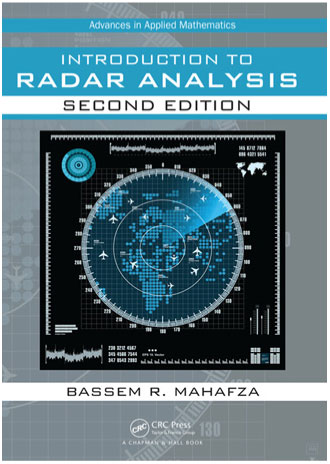
This substantial text by Bassem Mahafza is suggested by the author as an expansion of and significant rewriting of his initial publication of 1998, similarly entitled. The author helpfully indicates that this book on radar systems analysis is aimed particularly at the university student as a course textbook. With the inclusion of set problems at the end of each chapter and a final chapter on design case studies, this reader focus is apparent. The book is also relevant to the practicing radar systems engineer but, unlike a reference radar systems analysis textbook, such as David Barton’s well-known treatise, it is not a direct alternative.
As may be anticipated in a serious radar systems analysis book, it is highly mathematical. The heavy reliance upon maths should not discourage any professional reader since it is generally clearly presented in a readable and understandable manner. Although, while I have not had the opportunity to check and confirm the accuracy of every mathematical equation, I commend the author on the style and quality of his maths presentation. This should be of particular benefit to a course student.
The coverage of the topic of radar systems analysis in the book is wide, including basic relevant mathematical principles (e.g. transforms), communications fundamentals (e.g. modulation classes), the radar range equation and radar system concepts (e.g. range and Doppler measurement) in Part I of the book.
In Part II, he continues to develop in more detail continuous wave (CW) and pulsed radar aspects (e.g. coding, ambiguity resolution and pulse compression).
In Part III, he progresses to what he calls ‘special topics in radar systems’, which is rather curious, in my opinion, since it covers the many general and fundamental issues of effective radar system operation including clutter, basic radar detection and tracking. It is interesting that within Part III he devotes the chapter to phased array antennas including array types (e.g. linear, circular, rectangular), tapering (weighting), geometrical considerations and radiation pattern computation. I particularly complement him on the quality of the presentation of the 2D and 3D pattern plots. However, the almost total omission of consideration of reflector antennas, apart from a brief elusion in the tracking chapter is, perhaps, surprising. In the final chapter he introduces synthetic aperture radar (SAR), which, while serving as an interesting summary introduction, does seem to be slightly curious since he has not introduced the topics of airborne radar, bistatic/multistatic, ground probing radar, etc.
I do have to be slightly critical of his chapter covering matched filtering and the radar ambiguity function. Whilst such coverage is entirely necessary and appropriate, it is an omission that the author has not referred to the original and definitive work on the ambiguity function of P. M. Woodward and indeed to Woodward’s work on the statistical problem of reception and information theory.
In conclusion, a generally well-written and practical course textbook for the student but also with relevance to the experienced radar engineer. Perhaps its place is as a complement to other texts including M. I. Skolnik’s Radar Handbook (McGraw-Hill Education. 2008 – Third edition) and D. K. Barton’s Modern Radar System Analysis (Artech House 1988), which was updated as Radar System Analysis and Modelling (Artech House 2005).




